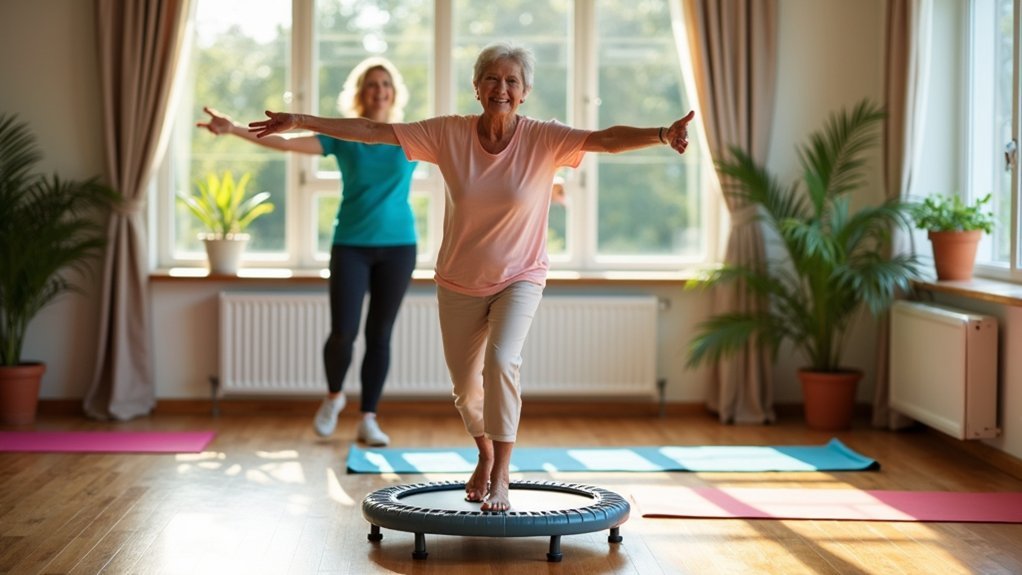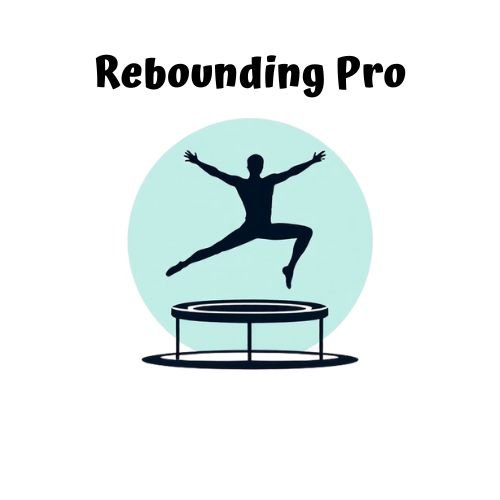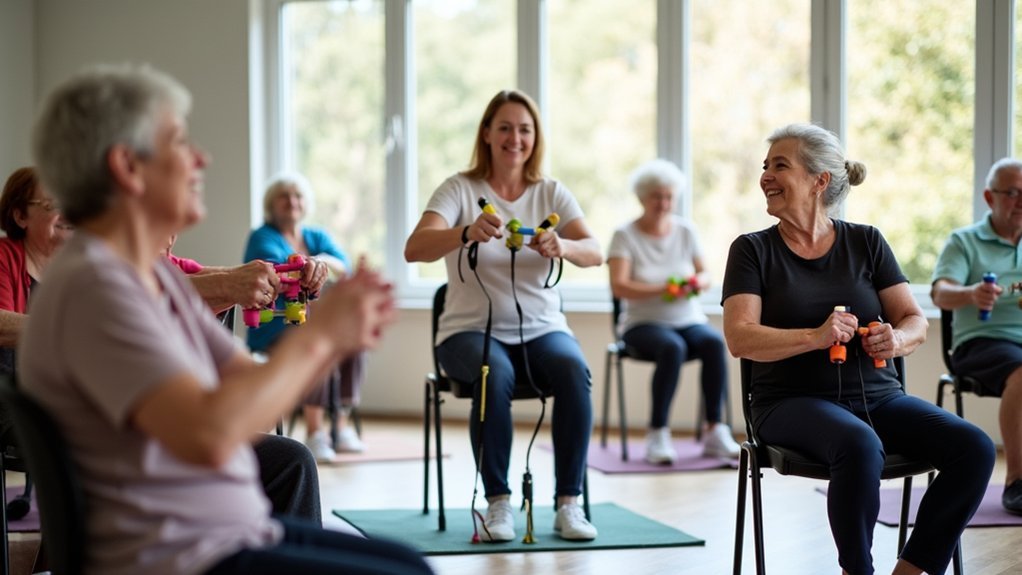Mini trampoline exercises offer powerful lymphatic drainage benefits without special equipment. Try the Basic Bounce for foundational flow, Heel Lift Variations for lower body drainage, Twist and Pump movements for abdominal lymphatics, Upper Body Combinations for axillary stimulation, Health Bounce progressions for beginners, Side-to-Side rebounding for lateral chains, and Deep Breathing techniques to maximize results. Combine these exercises with proper hydration for just 10-15 minutes daily to transform your lymphatic health.
Basic Bounce: The Foundation of Lymphatic Flow

While many exercise routines focus on cardiovascular health or muscle building, the basic bounce on a mini-trampoline uniquely targets your lymphatic system.
Unlike your circulatory system, lymph doesn’t have a central pump, relying instead on muscle movement and gravity to flow properly.
When you gently bounce, you create a pumping action that stimulates lymph flow throughout your body, enhancing toxin removal and supporting immune function.
This low-impact exercise is gentle on your joints while providing significant health benefits.
Start with just a few minutes of gentle bouncing in the morning and evening. Beginners should aim for 1-2 minute sessions before gradually increasing duration.
You don’t need intense jumping—even small, controlled movements effectively move lymphatic fluid.
As you become comfortable, you can gradually increase your session length or incorporate variations to keep your routine engaging.
Heel Lift Variations to Activate Lower Extremity Drainage
Elevate your lymphatic drainage routine with heel lift variations that specifically target the lower body.
These exercises stimulate calf muscles, enhancing venous return and reducing lymphedema-related swelling.
Try alternating between toe and heel lifts for dynamic circulation in your ankles and feet. For added challenge, perform single-leg heel lifts to improve balance while maximizing drainage.
Control your movements—slow, deliberate lifts optimize the muscle pump effect that moves lymphatic fluid efficiently.
Incorporate a stable support if needed, and remember that proper hydration is essential for effective results.
You’ll benefit most by combining heel lifts with other activities like yoga or walking, while maintaining your compression garments during exercise for enhanced pressure support.
Monitor your body’s response and gradually increase repetitions as your tolerance improves. Daily practice of these exercises for just 10-15 minutes can provide significant benefits for lymphedema management.
Twist and Pump: Rotational Movements for Abdominal Lymphatics

Rotational movements serve as powerful catalysts for abdominal lymphatic drainage, effectively mobilizing fluid that often stagnates in this central region. By incorporating gentle twisting motions while maintaining core engagement, you’ll stimulate the network of lymphatic vessels throughout your abdomen.
- Perform gentle side-to-side twists while lying down, repeating 10-15 times per side to activate abdominal lymph nodes.
- Combine rotational exercises with diaphragmatic breathing to create internal pressure changes that propel lymph centrally.
- Add light manual pressure on your belly during breath cycles to enhance lymphatic flow.
- Maintain proper form with controlled core activation to compress lymph vessels without straining your lower back.
For maximum effectiveness, practice clockwise circular massage strokes between rotational sessions to further stimulate drainage pathways. Regular practice of short 5-15 minute sessions provides more effective results than occasional lengthy exercises.
Upper Body Combinations for Axillary Node Stimulation
The intricate axillary lymph node network serves as a critical hub for upper body fluid circulation, making targeted stimulation essential for effective lymphatic drainage.
Combine shoulder blade squeezes with controlled sideways arm raises to activate drainage pathways around your scapula and axilla. Perform 10 gentle repetitions while maintaining steady breathing.
For deeper stimulation, alternate between elbow bends and isometric hand presses. Press your palms together firmly while engaging your shoulder muscles, then release.
Follow with slow backward shoulder rolls to enhance circulation through the axillary chain. Always remember to wear compression garments during these exercises to maximize lymphatic fluid movement and prevent swelling.
Complete your routine with hand activations – alternate between wrist circles, fist clenching, and finger movements to promote distal-to-proximal lymph flow.
These combined movements create an effective pumping action, directing fluid through your axillary nodes for ideal drainage.
Health Bounce Progressions for Beginners and Seniors

Health bounce progressions offer gentle yet effective lymphatic stimulation, particularly for those just beginning their rebounding journey or seniors seeking low-impact exercise.
You’ll find these movements preserve joint health while still delivering cardiovascular benefits.
- Start with gentle walking in place – maintaining balance while barely lifting your feet off the rebounder.
- Progress to small, controlled bounces – keeping feet in contact with the surface while bending knees slightly.
- Add gentle arm circles – incorporate upper body movement to enhance lymphatic flow through the axillary nodes.
- Try seated bouncing – an excellent option if you have balance concerns, simply sit and gently bounce while engaging your core.
This low-impact exercise is easier on joints compared to running or hard-surface activities while still promoting effective lymphatic drainage.
Always use a stabilizing bar if needed and limit initial sessions to 10-15 minutes.
Side-to-Side Rebounding for Lateral Lymph Chain Activation
Shifting your body weight from side to side on a rebounder activates essential lymphatic pathways that vertical bouncing alone might miss. This motion engages your obliques and gluteus medius while creating hydraulic pressure gradients that enhance drainage throughout your thoracic and abdominal lymph chains.
Start with a slight knee bend, then transfer weight laterally while maintaining balance. If you’re a beginner, hold handlebars for stability or reduce your range of motion. The safety handle provides important support for those with balance concerns during lateral movements.
To progress, vary your tempo between slow shifts and quicker changes, or add arm movements to intensify thoracic pump engagement.
For best results, perform 30-second side-to-side intervals alternated with vertical bouncing. Stay hydrated with 8-16oz water before and after your session to support proper lymph fluid viscosity and circulation.
Deep Breathing Techniques to Enhance Your Rebounding Results
While bouncing activates your lymphatic system through physical movement, proper breathing multiplies these benefits exponentially. Diaphragmatic breathing stimulates the thoracic duct and creates a “wringing” effect on lymph nodes, dramatically increasing fluid flow throughout your body.
- Belly Breathing Basics – Inhale through your nose allowing your abdomen to expand, then exhale through pursed lips while your belly contracts.
- Pressure Enhancement – Place hands gently on your abdomen during exhalation to increase lymphatic stimulation.
- Rhythm Integration – Sync your breath with rebounding movements (inhale on up-bounce, exhale on down-bounce).
- Pre/Post Routine – Perform 3-5 deep breaths before and after rebounding to maximize lymphatic drainage. Since the lymphatic system lacks an active pump, diaphragmatic breathing becomes essential for promoting efficient lymph movement throughout the body.
These techniques require no additional equipment and can greatly reduce swelling while enhancing your overall rebounding benefits.
Frequently Asked Questions
Can Rebounding Help With Specific Conditions Like Lymphedema or Fibromyalgia?
Yes, rebounding can help with lymphedema by stimulating lymphatic valves and reducing swelling. For fibromyalgia, it’s beneficial as a low-impact exercise that improves circulation while minimizing joint stress and potentially boosting proprioception.
How Do I Clean and Maintain My Mini-Trampoline for Optimal Performance?
Regularly remove debris and wipe your mini-trampoline with mild soap. Rinse thoroughly and air-dry completely. Check springs, frame, and bolts monthly for wear. Replace damaged parts promptly to maintain bounce and safety.
Is Rebounding Safe During Pregnancy or With Herniated Discs?
Rebounding requires medical clearance during pregnancy and with herniated discs. You’ll need significant modifications if approved—use handlebars, stick to gentle bouncing, and stop immediately if you experience pain or discomfort.
What’s the Difference Between Lymphatic and Cardiovascular Benefits of Rebounding?
Rebounding boosts your lymphatic system by removing toxins and strengthening immunity, while cardiovascular benefits include improving heart strength, lowering blood pressure, and increasing oxygen circulation. Both systems work together but target different bodily functions.
Can I Combine Rebounding With Intermittent Fasting or Detox Protocols?
Yes, you can combine rebounding with intermittent fasting or detox protocols. The gentle lymphatic stimulation complements detoxification processes while being low-impact enough for periods when your energy might be lower during fasting regimens.
In Summary
You’ve now discovered seven powerful ways to boost your lymphatic system on your mini trampoline. By incorporating these exercises into your routine, you’ll stimulate fluid movement, reduce inflammation, and enhance your body’s natural detoxification. Remember, consistency is key—even 10 minutes daily can make a difference. Start with what feels comfortable, then gradually increase intensity as your body adapts to this effective, low-impact form of lymphatic drainage.





Leave a Reply